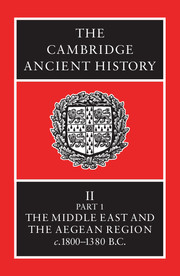Book contents
- Frontmatter
- Contents
- List of Maps
- List of Tables
- List of Text-figures
- Preface
- CHAPTER I NORTHERN MESOPOTAMIA AND SYRIA
- CHAPTER II EGYPT: FROM THE DEATH OF AMMENEMES III TO SEQENENRE II
- CHAPTER III PALESTINE IN THE MIDDLE BRONZE AGE
- CHAPTER IV
- CHAPTER V HAMMURABI AND THE END OF HIS DYNASTY
- CHAPTER VI ANATOLIA c. 1750–1600 B.C.
- CHAPTER VII PERSIA c. 1800–1550 B.C.
- CHAPTER VIII EGYPT: FROM THE EXPULSION OF THE HYKSOS TO AMENOPHIS I
- CHAPTER IX EGYPT: INTERNAL AFFAIRS FROM TUTHMOSIS I TO THE DEATH OF AMENOPHIS III
- CHAPTER X SYRIA c. 1550–1400 B.C.
- CHAPTER XI PALESTINE IN THE TIME OF THE EIGHTEENTH DYNASTY
- CHAPTER XII THE ZENITH OF MINOAN CIVILIZATION
- CHAPTER XIII THE LINEAR SCRIPTS AND THE TABLETS AS HISTORICAL DOCUMENTS
- CHAPTER XIV THE RISE OF MYCENAEAN CIVILIZATION
- CHAPTER XV ANATOLIA c. 1600–1380 b.c.
- CHAPTER XVI THE ARCHAEOLOGICAL EVIDENCE OF THE SECOND MILLENNIUM B.C. ON THE PERSIAN PLATEAU
- BIBLIOGRAPHIES
- Chronological Tables
- Index to Maps
- General Index
- Map 1: Greece and the Aegean Islands in the Middle Bronze Age.
- Map 3: Babylonia and Western Persia.
- Fig. 7. Plan of the Palace at Cnossus.
- Map 6: Ancient Asia Minor and Northern mesopotamia
- References
CHAPTER XVI - THE ARCHAEOLOGICAL EVIDENCE OF THE SECOND MILLENNIUM B.C. ON THE PERSIAN PLATEAU
Published online by Cambridge University Press: 28 March 2008
- Frontmatter
- Contents
- List of Maps
- List of Tables
- List of Text-figures
- Preface
- CHAPTER I NORTHERN MESOPOTAMIA AND SYRIA
- CHAPTER II EGYPT: FROM THE DEATH OF AMMENEMES III TO SEQENENRE II
- CHAPTER III PALESTINE IN THE MIDDLE BRONZE AGE
- CHAPTER IV
- CHAPTER V HAMMURABI AND THE END OF HIS DYNASTY
- CHAPTER VI ANATOLIA c. 1750–1600 B.C.
- CHAPTER VII PERSIA c. 1800–1550 B.C.
- CHAPTER VIII EGYPT: FROM THE EXPULSION OF THE HYKSOS TO AMENOPHIS I
- CHAPTER IX EGYPT: INTERNAL AFFAIRS FROM TUTHMOSIS I TO THE DEATH OF AMENOPHIS III
- CHAPTER X SYRIA c. 1550–1400 B.C.
- CHAPTER XI PALESTINE IN THE TIME OF THE EIGHTEENTH DYNASTY
- CHAPTER XII THE ZENITH OF MINOAN CIVILIZATION
- CHAPTER XIII THE LINEAR SCRIPTS AND THE TABLETS AS HISTORICAL DOCUMENTS
- CHAPTER XIV THE RISE OF MYCENAEAN CIVILIZATION
- CHAPTER XV ANATOLIA c. 1600–1380 b.c.
- CHAPTER XVI THE ARCHAEOLOGICAL EVIDENCE OF THE SECOND MILLENNIUM B.C. ON THE PERSIAN PLATEAU
- BIBLIOGRAPHIES
- Chronological Tables
- Index to Maps
- General Index
- Map 1: Greece and the Aegean Islands in the Middle Bronze Age.
- Map 3: Babylonia and Western Persia.
- Fig. 7. Plan of the Palace at Cnossus.
- Map 6: Ancient Asia Minor and Northern mesopotamia
- References
Summary
The second millennium B.C. remains one of the most poorly known of all of the archaeological periods on the Persian plateau. Older excavations and limited surveys, summarized in several important articles and books, have yielded scattered information about pottery styles and burial practices. The limited nature of this information has encouraged a renewal of field work relating to the second millennium during the past decade. As a result, there is now sufficient new evidence to permit a tentative restructuring of some aspects of the interpretative problems involved, particularly in regard to the western and northern border areas of the plateau. In these areas many of the cultural patterns dating to the early second millennium had their inception in the third millennium, and had disappeared, or had been greatly modified, by the end of the first quarter of the second millennium. Many of the cultural patterns which then developed were in turn terminated in the third quarter of the millennium by the onset of the new ethnic movements and major political changes of the beginning Iron Age.
THE LATE THIRD AND EARLY SECOND MILLENNIA B.C.
During the late third and early second millennia b.c. the Persian plateau was divided into distinct cultural areas as indicated by the distribution of ceramic tradition: the Gurgan Grey Ware in Gurgan province in the north-east; the Giyān IV–III Painted Ware in eastern Luristān; and, between the two, the Yanik
- Type
- Chapter
- Information
- The Cambridge Ancient History , pp. 686 - 715Publisher: Cambridge University PressPrint publication year: 1973



